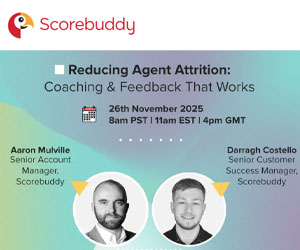This article assesses the risks inherent in channel blending in contact centres.
Channel blending is defined as having agents work on different types of contacts coming in – simultaneously.
This is a different scenario from having multi-skilled agents handle different types of contacts coming in but at different times.
These days, with more channels of communication used in contact centres, channel blending seems like a logical approach to improve productivity.
But there are risks inherent in channel blending that contact centre management need to factor into planning decisions.
If You Don’t Know Already – Please Learn Your Erlang C
Yes, your contact centre agents have available time.
Available time results from the dynamic of random contact arrival – with the outcome that at some times your agent is ‘occupied’, while at other times they are ‘available’.
The following formula applies:
Occupancy Rate + Available Rate = 100% for any given period of time
So, if your agent is 85% occupied that means they are experiencing a 15% availability rate over the same period.
Let’s do some maths using an hour as time basis:
- 85% Occupancy x 60 minutes = 51 minutes of being occupied
- 5% Available x 60 minutes = 9 minutes of being available
But those 9 minutes, spread over the course of an hour, come in bits and bursts.
5 seconds here…42 seconds there…1 minute here and so on.
So, the question is:
Does it really work to ask your agents to handle other contacts during these bits and bursts of Available Time?
Obviously, when Occupancy rates are very low, it makes sense to switch attention to other work.
But in contact centres which aim to achieve service level interval after interval, occupancy rates don’t fluctuate wildly.
Channel Blending – Handling Multiple Channels of Contact at the Same Time
Can agents viably handle channels such as live chat or emails while logged in to handle voice calls at the same time (or over the same time period)?
Smart practitioners and organisations that pursue customer experience say no.
It all sounds so good on paper, so why not?
It’s simple.
Quality and the customer experience – and all that goes with it like First Contact Resolution (FCR) – will suffer in this scenario.
Try writing a clear and well-presented reply to a customer email while being interrupted any number of times by voice calls.
Try jumping back and forth between a live chat (or three) and a voice call and ensure you handle them all well.
Now try doing this hour after hour, day after day, month after month.
I watch a lot of industry recruitment videos and in these videos you hear about the need for a contact centre/customer service professional to listen well and give their undivided attention to the customer. To create a memorable and positive experience to build loyalty and trust.
All noble stuff.
But the implementation of channel blending (as defined in this article) flies directly in the face of great customer service and is a bit hypocritical at the end of the day.
Wikipedia gives us this gem:
“Human multi-tasking is an apparent human ability to perform more than one task, or activity, over a short period of time.”
“An example of multi-tasking is taking phone calls while typing an email and reading a book.”
“Multi-tasking can result in time wasted due to human context switching and apparently causing more errors due to insufficient attention.”
Jeff Toister, a customer Service expert, writes:
Multi-tasking and customer service don’t mix.
- We can only process one conscious thought at a time
- Multi-tasking slows us down
- We make more errors when we multi-task
I recommend reading Jeff’s full article on the topic at the link below – it’s a winner.
Wikipedia carries on with the origin of the term ‘multi-tasking’:
“The first published use of the word ‘multi-task’ appeared in an IBM paper describing the capabilities of the IBM System 360 in 1965.”
“In this context, ‘multi-tasking’ refers to the ability of a computer to apparently process several tasks, or computer jobs, concurrently.”
The term has since been applied to human tasks.
It’s Not About the Attitude of Your Frontline Team Members
Recently, I met a contact centre agent at a workshop and she said that yes, it had been hard to handle multiple channels at the same time – but she seemed to chalk it up to attitude.
“It was hard – especially at the beginning. But I have a correct attitude, so I really tried and got used to it over time…”
But let’s take that argument a bit further.
For those who struggle with handling multiple channels at the same time, does this mean that they don’t have the right attitude?
Her statement made me sad because I had to wonder – how many others out there in the industry are blaming attitude on their failure to achieve ‘success’ in channel blending.
The World Has Changed
Most contact centres recognise that their call mix has changed radically over the past years.
Nowadays the voice channel is not the ‘first choice’ for most and tends to be used for only the more complex or challenging situations.
This means the agent job role has become even more difficult than it was before (just ask an agent).
Organisations that focus on customer experience allow their agents to deliver on the customer experience – especially when faced with increasing complexity.
Channel Blending Is Not About Being Omnichannel
Omnichannel is about the customer experience.
Being able to maintain a seamless, ‘single’ conversation with a customer across multiple channels of communication.
But, being ‘omnichannel’, a customer experience strategy is not the same as channel blending, which damages the customer experience (as well as the agent experience).
Does it make sense to train team members across different channels of communication?
Absolutely!
This is where the work can get really interesting for the agent and the planning gets much easier for the centre.
Handling different channels, at different scheduled intervals, is a sign of healthy forecasting and scheduling.
Channel blending, though beautiful on paper, is a misguided attempt to achieve productivity.
Author: Guest Author
Published On: 20th Nov 2017
Read more about - Guest Blogs





































